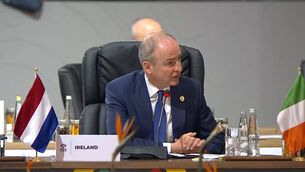Buses travelling deliberately slower 'unbelievably frustrating' for commuters

National Transport Authority chief executive Anne Graham said Dublin Bus and Go-Ahead Ireland had contractual standards they must meet regarding punctuality and not departing earlier than scheduled times on the route. File picture: Gareth Chaney/Collins Photos
Some bus services in Dublin have been deliberately going slower and waiting longer at bus stops to make sure they reach their destinations on schedule in a move that has been described as “unbelievably frustrating” for commuters.
This may have been more noticeable in recent months, according to the National Transport Authority (NTA), as lighter traffic on the roads and fewer passengers on routes has resulted in faster bus speeds than scheduled.
NTA chief executive Anne Graham also said it had resulted in more waiting at bus stops to catch up time and keep to schedule.
The issue was raised by Solidarity-PBP TD Bríd Smith, who said the NTA’s position shows “an alarming disconnect between the people responsible for public transport and the experience of passengers using the service”.
In a response to a parliamentary question from Ms Smith, Ms Graham said Dublin Bus and Go-Ahead Ireland had contractual standards they must meet regarding punctuality and not departing earlier than scheduled times on the route.
She said: “The aim of the standards is to provide more certainty and predictability to bus passengers intending to use the service.
Ms Graham said that, on higher frequency routes, reducing early departures can reduce bunching. This is where buses leaving a terminus at regular times can catch up on each other mid-route and then leave a long gap in service behind them.
She said regulating bus speeds to reduce early departures from specific points was a standard approach used worldwide, and pointed out this may have been more pronounced in recent months.
“This is because lighter traffic conditions and fewer passengers than expected in December and January due to Covid restrictions have resulted in faster bus speeds than scheduled by the operator and more waiting at stops to catch up time and keep to schedule,” she said.
“We expect the level of waiting at stops will reduce as traffic increases following easing of restrictions, and as operators adjust schedules where required to reflect changed traffic conditions.”
Ms Smith said passengers had been facing “unbelievable delays and complete frustration” for months as a result of these measures.
"Essentially the NTA have allocated timing to buses that is a match to extreme traffic conditions and high passenger numbers; when one or other don’t materialise the buses are still expected to drive and meet times at every bus stop regardless,” she said.
She said that real-time information was widely available and there is no reason for this “extreme version” of timing points to be used.
“On some routes, drivers are moving at 20 to 30km a hour and still have to wait for several minutes at some stops,” Ms Smith added. “It is unbelievably frustrating for people trying to get to work or college.”










